Autoimmune Thyroid Disease and Female Fertility: Does Anti-TPO Accelerate Ovarian Aging?
Abstract
1. Introduction
2. Materials and Methods
2.1. Study Design and Setting
2.2. Study Population and Eligibility Criteria
2.3. Inclusion Criteria
2.4. Data Collection
Subgroup Definitions
2.5. Statistical Analyses
2.6. Sample Size and Power
2.7. Study Limitations
2.8. Results
3. Discussion
4. Clinical Recommendations
5. Study Strengths and Limitations
6. Future Directions
7. Conclusions
Author Contributions
Funding
Institutional Review Board Statement
Data Availability Statement
Acknowledgments
Conflicts of Interest
Abbreviations
| AMH | Anti-Müllerian Hormone |
| AFC | Antral Follicle Count |
| BMI | Body mass index |
| DOR | Diminished ovarian reserve |
| E2 | Estradiol |
| Ft3 | Free Triiyodotironin |
| Ft4 | Free Tiroksin |
| HT | Hashimoto’s thyroiditis |
| hCG | Human chorionic gonadotropin |
| IVF | İn vitro fertilization |
| PCOS | Polycystic ovary syndrome |
| POI | Premature ovarian insufficiency |
| FSH | Follicle-Stimulating Hormone |
| LH | Luteinizing hormone |
| TAI | Thyroid autoimmunity |
| Anti-Tpo | Thyroid peroxidase antibodies |
| TVS | Transvaginal ultrasound |
References
- Kirshenbaum, M.; Orvieto, R. Premature ovarian insufficiency (POI) and autoimmunity-an update appraisal. J. Assist. Reprod. Genet. 2019, 36, 2207–2215. [Google Scholar] [CrossRef]
- Halici, M.; Seker, M.E.; Gebedek, I.Y.; Gokbak, M.N.; Cetisli, A.F.; Ciftci, A.B.; Konac, E.; Kopuk, S.Y.; Tiras, B.; Cakiroglu, Y. Thyroid hormones and ovarian reserve: A comprehensive study of women seeking infertility care. BMC Womens Health 2023, 23, 570. [Google Scholar] [CrossRef]
- Huang, Y.; Xie, B.; Li, J.; Hang, F.; Hu, Q.; Jin, Y.; Qin, R.; Yu, J.; Luo, J.; Liao, M.; et al. Prevalence of thyroid autoantibody positivity in women with infertility: A systematic review and meta-analysis. BMC Womens Health 2024, 24, 630. [Google Scholar] [CrossRef]
- Busnelli, A.; Beltratti, C.; Cirillo, F.; Bulfoni, A.; Lania, A.; Levi-Setti, P.E. Impact of Thyroid Autoimmunity on Assisted Reproductive Technology Outcomes and Ovarian Reserve Markers: An Updated Systematic Review and Meta-Analysis. Thyroid 2022, 32, 1010–1028. [Google Scholar] [CrossRef]
- Hasegawa, Y.; Kitahara, Y.; Osuka, S.; Tsukui, Y.; Kobayashi, M.; Iwase, A. Effect of hypothyroidism and thyroid autoimmunity on the ovarian reserve: A systematic review and meta-analysis. Reprod. Med. Biol. 2022, 21, e12427. [Google Scholar] [CrossRef] [PubMed]
- Szeliga, A.; Calik-Ksepka, A.; Maciejewska-Jeske, M.; Grymowicz, M.; Smolarczyk, K.; Kostrzak, A.; Smolarczyk, R.; Rudnicka, E.; Meczekalski, B. Autoimmune Diseases in Patients with Premature Ovarian Insufficiency-Our Current State of Knowledge. Int. J. Mol. Sci. 2021, 22, 2594. [Google Scholar] [CrossRef]
- Bucci, I.; Giuliani, C.; Di Dalmazi, G.; Formoso, G.; Napolitano, G. Thyroid Autoimmunity in Female Infertility and Assisted Reproductive Technology Outcome. Front. Endocrinol. 2022, 13, 768363. [Google Scholar] [CrossRef]
- Monteleone, P.; Parrini, D.; Faviana, P.; Carletti, E.; Casarosa, E.; Uccelli, A.; Cela, V.; Genazzani, A.R.; Artini, P.G. Female infertility related to thyroid autoimmunity: The ovarian follicle hypothesis. Am. J. Reprod. Immunol. 2011, 66, 108–114. [Google Scholar] [CrossRef]
- Poppe, K.; Glinoer, D.; Tournaye, H.; Devroey, P.; Schiettecatte, J.; Haentjens, P.; Velkeniers, B. Thyroid autoimmunity and female infertility. Verh. K Acad. Geneeskd. Belg. 2006, 68, 357–377. [Google Scholar] [PubMed]
- Goswami, R.; Marwaha, R.K.; Goswami, D.; Gupta, N.; Ray, D.; Tomar, N.; Singh, S. Prevalence of thyroid autoimmunity in sporadic idiopathic hypoparathyroidism in comparison to type 1 diabetes and premature ovarian failure. J. Clin. Endocrinol. Metab. 2006, 91, 4256–4259. [Google Scholar] [CrossRef] [PubMed]
- Brennan, A.; Hickey, M. Management of Early Menopause/Premature Ovarian Insufficiency in Women with or at High Risk of Breast Cancer. Semin. Reprod. Med. 2020, 38, 309–314. [Google Scholar] [CrossRef] [PubMed]
- The ESHRE Guideline Group on POI; Webber, L.; Davies, M.; Anderson, R.; Bartlett, J.; Braat, D.; Cartwright, B.; Cifkova, R.; de Muinck Keizer-Schrama, S.; Hogervorst, E.; et al. ESHRE Guideline: Management of women with premature ovarian insufficiency. Hum. Reprod. 2016, 31, 926–937. [Google Scholar] [CrossRef] [PubMed]
- Domniz, N.; Meirow, D. Premature ovarian insufficiency and autoimmune diseases. Best Pract. Res. Clin. Obstet. Gynaecol. 2019, 60, 42–55. [Google Scholar] [CrossRef]
- Altuntas, S.C. Differences in Thyroid Autoimmunity and Thyroid Function Tests Between Individuals with and without Obesity: Is There a Correlation with Obesity Degree? Endocr. Metab. Immune Disord. Drug Targets 2025, 25, 1–9. [Google Scholar] [CrossRef]
- Romitti, M.; Fabris, V.C.; Ziegelmann, P.K.; Maia, A.L.; Spritzer, P.M. Association between PCOS and autoimmune thyroid disease: A systematic review and meta-analysis. Endocr. Connect. 2018, 7, 1158–1167. [Google Scholar] [CrossRef]
- Park, J.H.; Choi, T.S. Polycystic ovary syndrome (PCOS)-like phenotypes in the d-galactose-induced aging mouse model. Biochem. Biophys. Res. Commun. 2012, 427, 701–704. [Google Scholar] [CrossRef]
- Shrivastava, C.; Sagiraju, P.; Rajbhar, S.; Bansal, R.; Kodumuri, L. Association Between Serum Antinuclear Antibody and Polycystic Ovarian Syndrome in Reproductive Women Aged 18 to 35 Years: A Quest for an Autoimmune Marker. Cureus 2024, 16, e75224. [Google Scholar] [CrossRef]
- van der Ham, K.; Stekelenburg, K.J.; Louwers, Y.V.; van Dorp, W.; Schreurs, M.W.J.; van der Wal, R.; Steegers-Theunissen, R.P.M.; Laven, J.S.E. The prevalence of thyroid dysfunction and hyperprolactinemia in women with PCOS. Front. Endocrinol. 2023, 14, 1245106. [Google Scholar] [CrossRef] [PubMed]
- Li, J.; Huang, Q.; Sun, S.; Zhou, K.; Wang, X.; Pan, K.; Zhang, Y.; Wang, Y.; Han, Q.; Si, C.; et al. Thyroid antibodies in Hashimoto’s thyroiditis patients are positively associated with inflammation and multiple symptoms. Sci. Rep. 2024, 14, 27902. [Google Scholar] [CrossRef] [PubMed]
- Osuka, S.; Iwase, A.; Goto, M.; Takikawa, S.; Nakamura, T.; Murase, T.; Kato, N.; Bayasula; Kotani, T.; Kikkawa, F. Thyroid Autoantibodies do not Impair the Ovarian Reserve in Euthyroid Infertile Women: A Cross-Sectional Study. Horm. Metab. Res. 2018, 50, 537–542. [Google Scholar] [CrossRef]
- Hsieh, Y.T.; Ho, J.Y.P. Thyroid autoimmunity is associated with higher risk of premature ovarian insufficiency-a nationwide Health Insurance Research Database study. Hum. Reprod. 2021, 36, 1621–1629. [Google Scholar] [CrossRef]
- Ganie, M.A.; Kalra, S. Polycystic ovary syndrome—A metabolic malady, the mother of all lifestyle disorders in women—Can Indian health budget tackle it in future? Indian J. Endocrinol. Metab. 2011, 15, 239–241. [Google Scholar] [CrossRef] [PubMed]
- Janssen, O.E.; Hahn, S.; Tan, S.; Benson, S.; Elsenbruch, S. Mood and sexual function in polycystic ovary syndrome: A randomized controlled trial. J. Clin. Endocrinol. Metab. 2016, 101, 1943–1951. [Google Scholar] [CrossRef]
- Croce, L.; Beneventi, F.; Ripepi, F.; De Maggio, I.; Malovini, A.; Bellingeri, C.; Coperchini, F.; Teliti, M.; Rotondi, M.; Spinillo, A.; et al. Relationship between maternal obesity and first-trimester TSH in women with negative anti-TPO antibodies. Eur. Thyroid J. 2024, 13, e230213. [Google Scholar] [CrossRef]
- Krishnamurthy, H.; Suresh, C.; Siriwardhane, T.; Krishna, K.; Song, Q.; Jayaraman, V.; Wang, T.; Bei, K.; Rajasekaran, J.J. Association between thyroid dysfunction and insulin resistance: A retrospective cohort study. BMJ Open 2025, 15, e076397. [Google Scholar] [CrossRef]
- Yao, J.Y.; Liu, P.; Zhang, W.; Wang, K.W.; Lyu, C.P.; Zhang, Z.W.; Chen, X.L.; Chen, Y.; Wang, X.S.; Ding, Y.X.; et al. Obesity rather than Metabolic Syndrome is a Risk Factor for Subclinical Hypothyroidism and Thyroid Autoimmunity. Biomed. Environ. Sci. 2021, 34, 819–823. [Google Scholar] [CrossRef]
- Yang, Y.; Li, R.; Yang, W. The Relationship and Mechanisms Between Body Mass Index and Autoimmune Hypothyroidism: Insights from Mendelian Randomization. Obes. Surg. 2025, 35, 902–914. [Google Scholar] [CrossRef]
- Tersigni, C.; Castellani, R.; De Carolis, C.; Favilli, A.; Scambia, G.; Di Simone, N. Ovarian inflammation and autoimmunity. J. Reprod. Immunol. 2018, 130, 12–18. [Google Scholar]
- Khole, V. Does ovarian autoimmunity play a role in the pathophysiology of premature ovarian insufficiency? J. Midlife Health 2010, 1, 9–13. [Google Scholar] [CrossRef]
- Savukoski, S.M.; Silven, H.; Pesonen, P.; Pukkala, E.; Gissler, M.; Suvanto, E.; Ollila, M.M.; Niinimaki, M. Excess of severe autoimmune diseases in women with premature ovarian insufficiency: A population-based study. Hum. Reprod. 2024, 39, 2601–2607. [Google Scholar] [CrossRef]
- Koller, T.; Kollerova, J.; Hlavaty, T.; Kadleckova, B.; Payer, J. Ovarian Reserve Assessed by the Anti-Mullerian Hormone and Reproductive Health Parameters in Women With Crohn s Disease, a Case-Control Study. Physiol. Res. 2021, 70, S69–S78. [Google Scholar] [CrossRef] [PubMed]
- Franceschi, C.; Campisi, J. Chronic inflammation (inflammaging) and its potential contribution to age-associated diseases. J. Gerontol. A Biol. Sci. Med. Sci. 2014, 69 (Suppl. S1), S4–S9. [Google Scholar] [CrossRef]
- Agarwal, A.; Aponte-Mellado, A.; Premkumar, B.J.; Shaman, A.; Gupta, S. The effects of oxidative stress on female reproduction: A review. Reprod. Biol. Endocrinol. 2012, 10, 49. [Google Scholar] [CrossRef]
- Priya, A.; Sri, B.; Bala, G.; Kannan, S. Exploring Serum Anti-thyroid Peroxidase Antibodies and High-Sensitivity C-reactive Protein as Inflammatory Markers in Subclinical Hypothyroidism: A Comprehensive Study. Cureus 2025, 17, e76906. [Google Scholar] [CrossRef]
- Kloos, J.; Perez, J.; Weinerman, R. Increased body mass index is negatively associated with ovarian reserve as measured by anti-Mullerian hormone in patients with polycystic ovarian syndrome. Clin. Obes. 2024, 14, e12638. [Google Scholar] [CrossRef]
- Hu, X.; Chen, Y.; Shen, Y.; Zhou, S.; Fei, W.; Yang, Y.; Que, H. Correlation between Hashimoto’s thyroiditis and polycystic ovary syndrome: A systematic review and meta-analysis. Front. Endocrinol. 2022, 13, 1025267. [Google Scholar] [CrossRef] [PubMed]
- Racoubian, E.; Aimagambetova, G.; Finan, R.R.; Almawi, W.Y. Age-dependent changes in anti-Mullerian hormone levels in Lebanese females: Correlation with basal FSH and LH levels and LH/FSH ratio: A cross-sectional study. BMC Womens Health 2020, 20, 134. [Google Scholar] [CrossRef] [PubMed]
- Monteleone, P.; Parrini, D.; Faviana, P.; Casarosa, E.; Uccelli, A.; Cela, V.; Artini, P.G. Immunological mechanisms in autoimmune ovarian failure. Am. J. Reprod. Immunol. 2011, 66, 157–163. [Google Scholar]
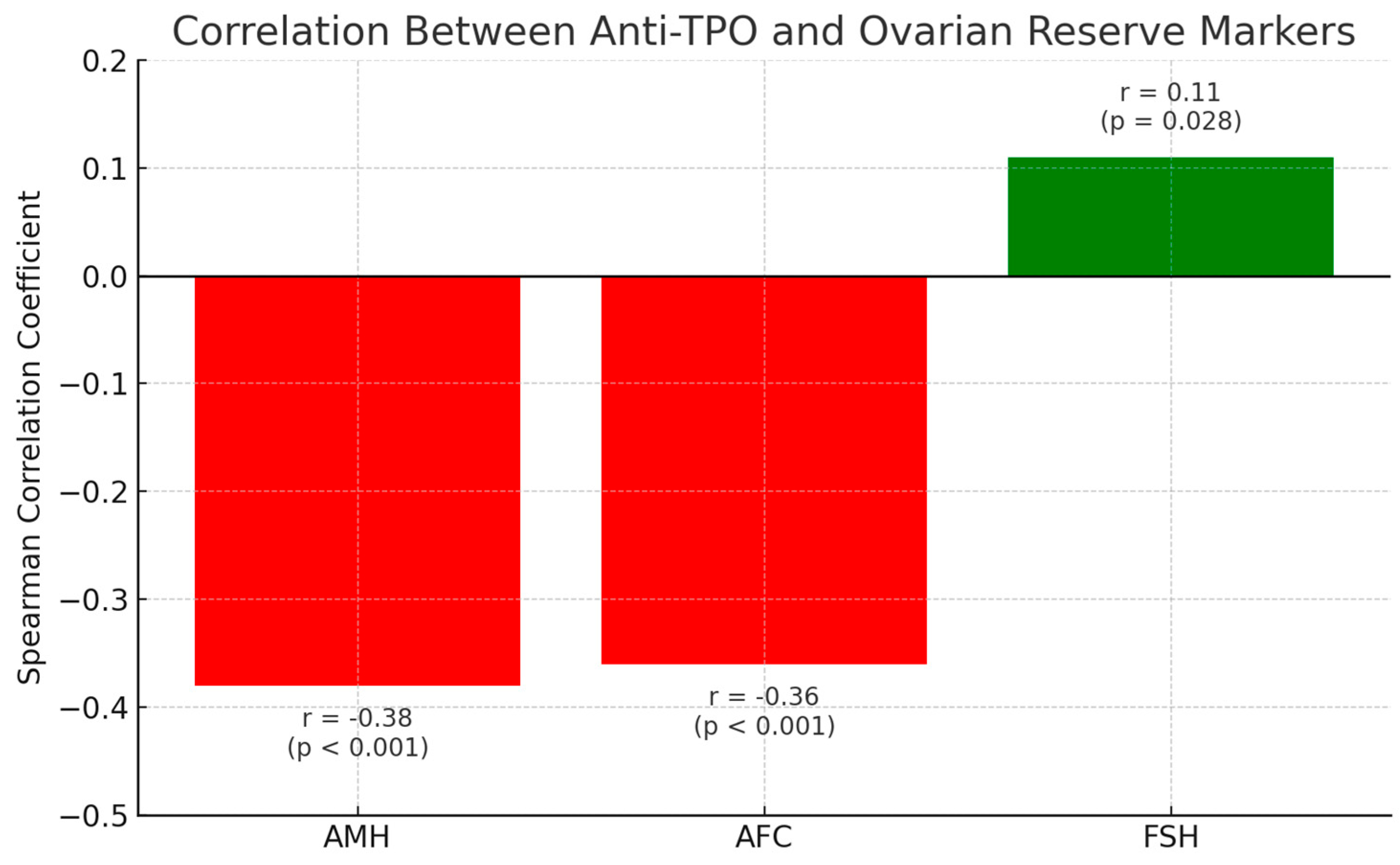

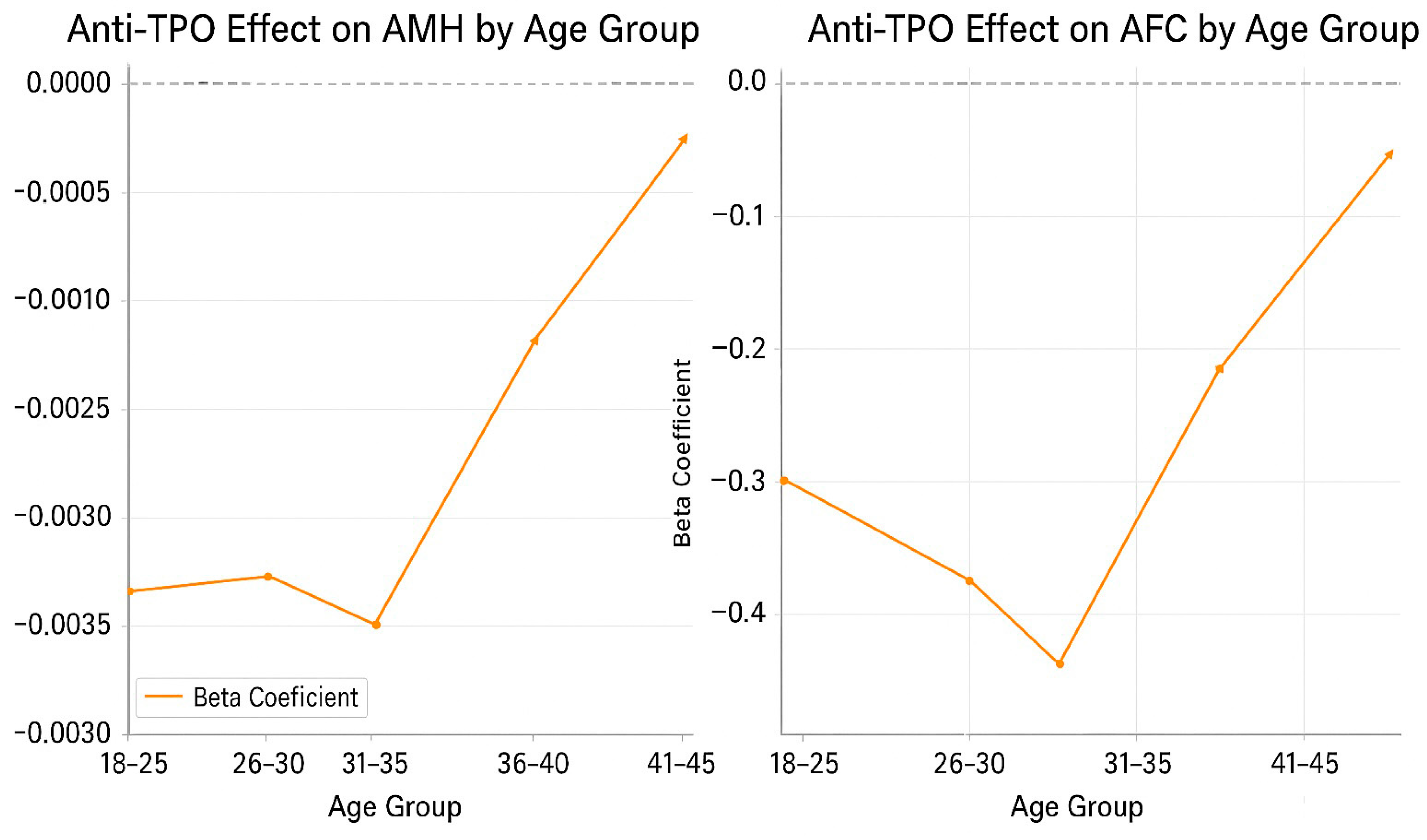
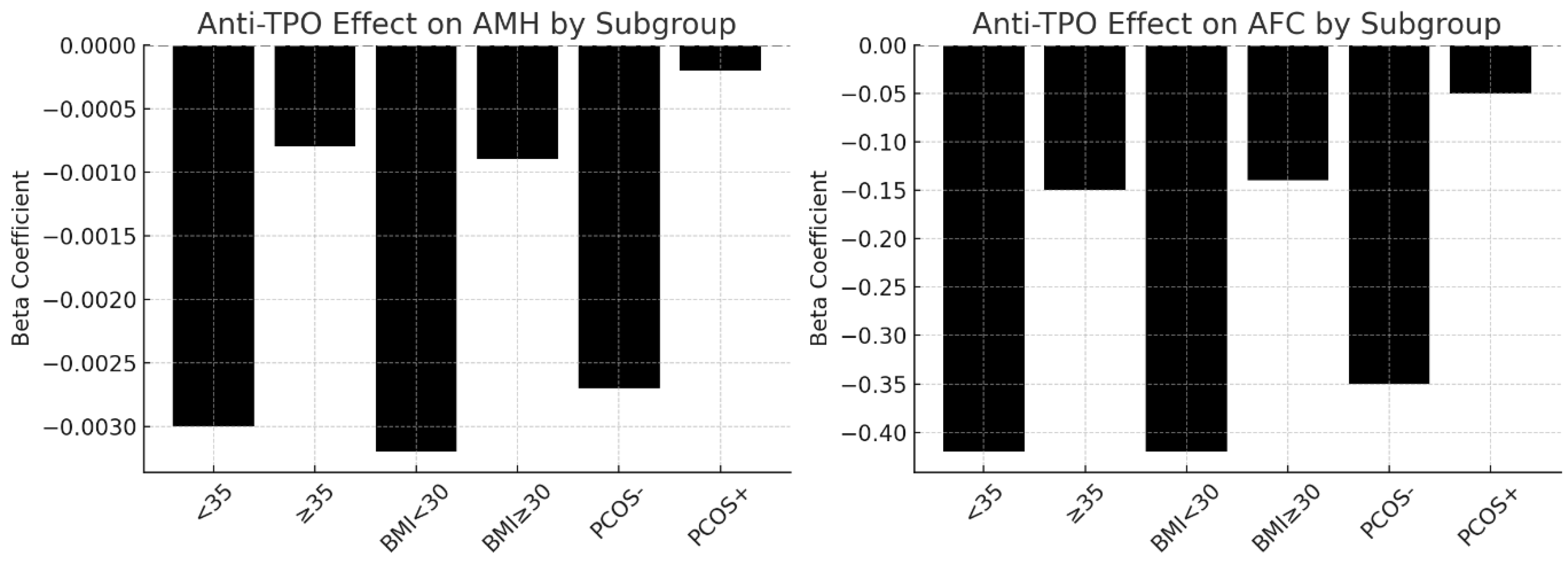
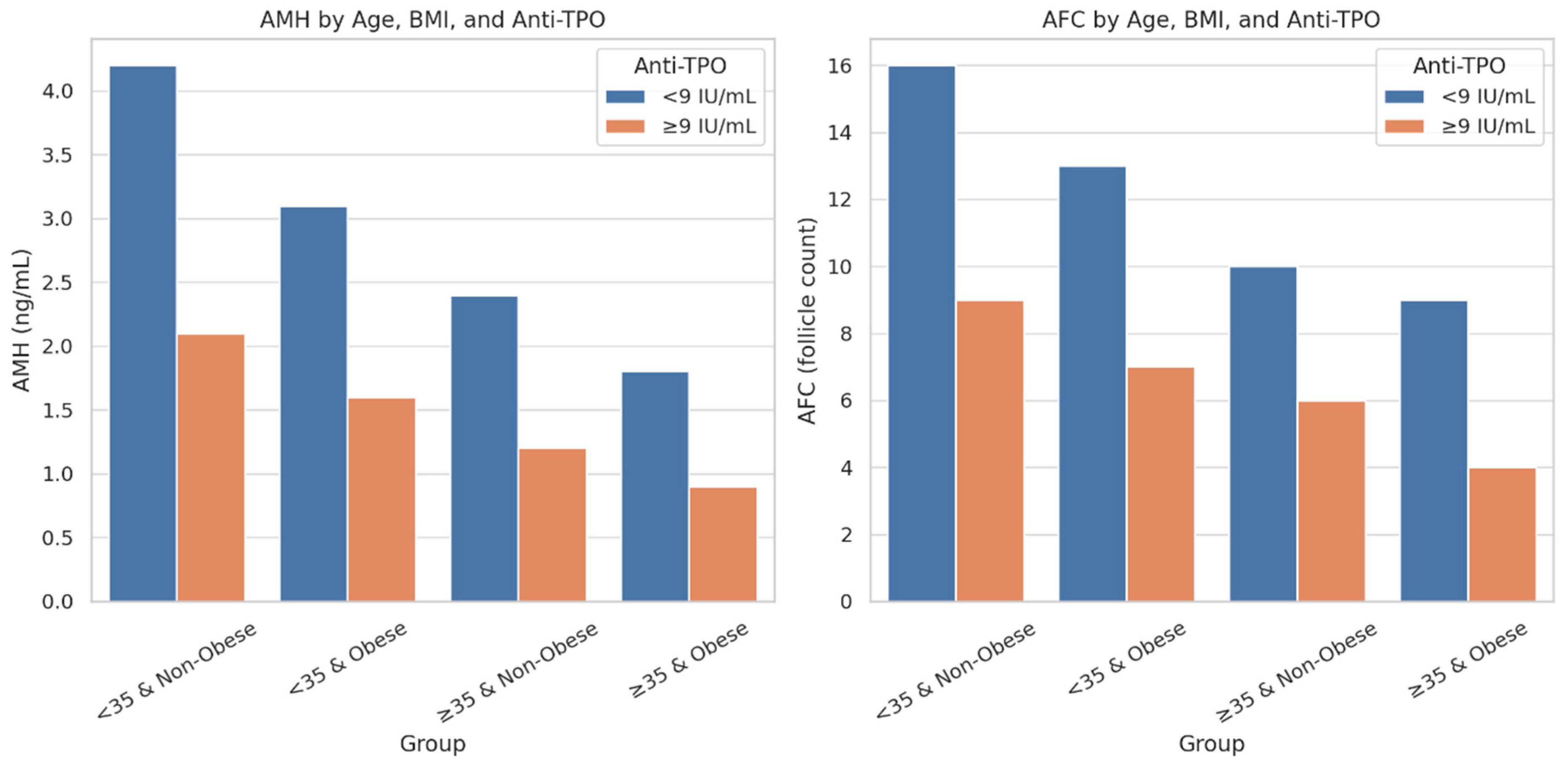
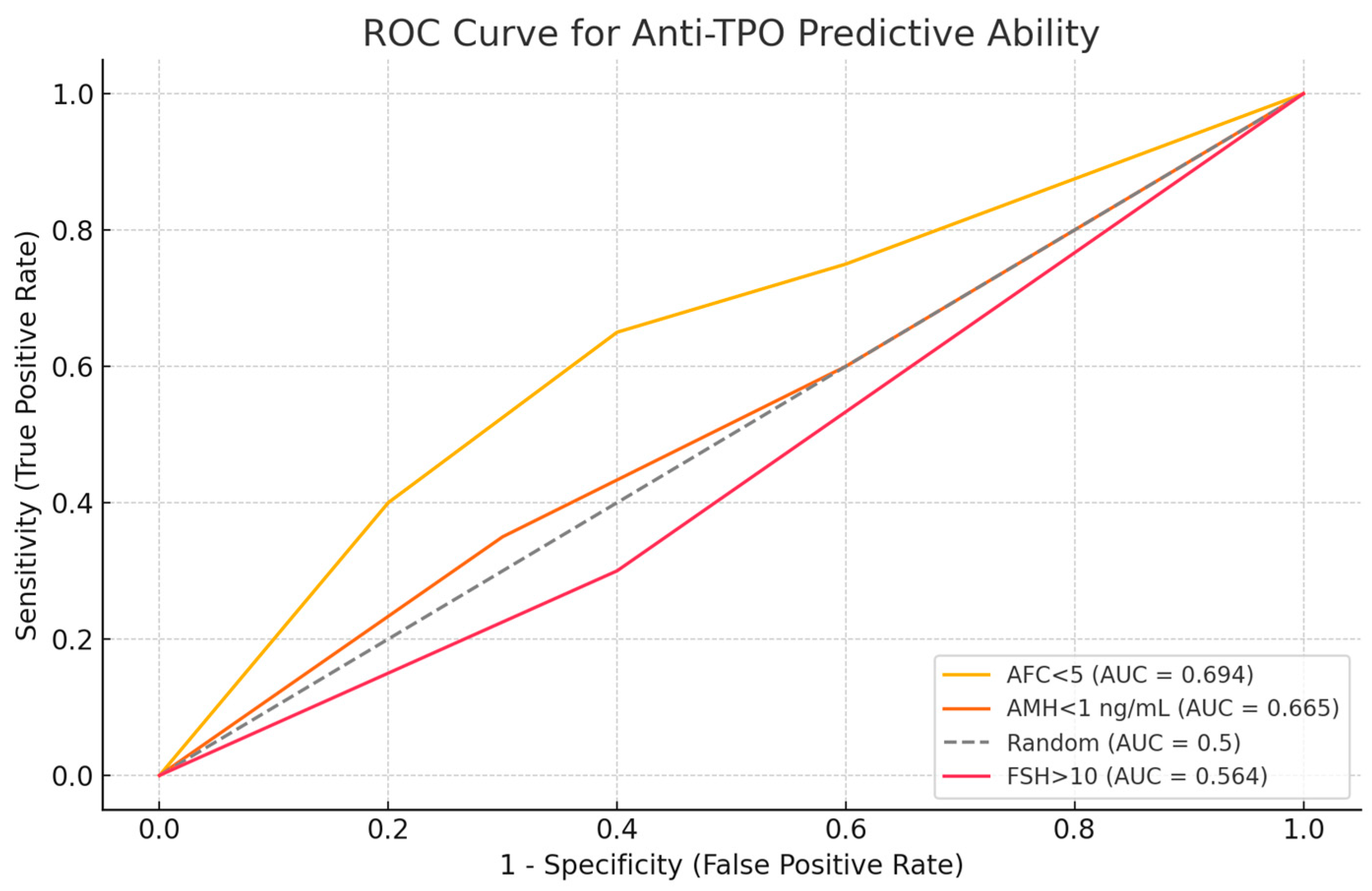

| Anti-TPO (−) (n = 1203) | Anti-TPO (+) (n = 257) | p Value | |
|---|---|---|---|
| Age (year) | 31.45 ± 5.66 | 32.61 ± 5.76 | 0.033 |
| BMI (Kg/m2) | 26.15 ± 3.48 | 26.37 ± 3.69 | 0.469 |
| Obesity BMI (Kg/m2) ≥ 30 (n) | 144(17.7%) | 38(14.8%) | 0.213 |
| Duration of infertility (mounts) | 61.19 ± 18.84 | 61.24 ± 19.17 | 0.963 |
| Number of antral follicle count (AFC) (n) | 15.88 ± 8.18 | 8.18 ± 5.06 | <0.001 * |
| Anti-Mullerian hormone (AMH) ng/Ml | 3.34 ± 3.04 | 1.47 ± 1.53 | <0.001 * |
| Day 3 Follicle-stimulating hormone (FSH), mIU/ml | 8.06 ± 4.79 | 9.40 ± 6.21 | 0.001 * |
| Day 3 Luteinizing hormone (LH), mIU/ml | 6.65 ± 4.42 | 5.92 ± 3.85 | 0.015 * |
| Day 3 Estradiol (E2), pg/ml | 40.51 ± 26.36 | 39.85 ± 22.60 | 0.741 |
| Troide-stimulating hormone (TSH), mIU/ml | 1.93 ± 0.83 | 2.22 ± 1.11 | 0.002 * |
| Free Triiyodotironin (Ft3), pg/mL | 3.48 ± 0.41 | 3.46 ± 0.42 | 0.482 |
| Free Tiroksin (Ft4), ng/dL | 0.93 ± 0.13 | 0.92 ± 0.14 | 0.176 |
Disclaimer/Publisher’s Note: The statements, opinions and data contained in all publications are solely those of the individual author(s) and contributor(s) and not of MDPI and/or the editor(s). MDPI and/or the editor(s) disclaim responsibility for any injury to people or property resulting from any ideas, methods, instructions or products referred to in the content. |
© 2025 by the authors. Licensee MDPI, Basel, Switzerland. This article is an open access article distributed under the terms and conditions of the Creative Commons Attribution (CC BY) license (https://creativecommons.org/licenses/by/4.0/).
Share and Cite
Arlıer, S.; Kükrer, S. Autoimmune Thyroid Disease and Female Fertility: Does Anti-TPO Accelerate Ovarian Aging? J. Clin. Med. 2025, 14, 8024. https://doi.org/10.3390/jcm14228024
Arlıer S, Kükrer S. Autoimmune Thyroid Disease and Female Fertility: Does Anti-TPO Accelerate Ovarian Aging? Journal of Clinical Medicine. 2025; 14(22):8024. https://doi.org/10.3390/jcm14228024
Chicago/Turabian StyleArlıer, Sefa, and Sadık Kükrer. 2025. "Autoimmune Thyroid Disease and Female Fertility: Does Anti-TPO Accelerate Ovarian Aging?" Journal of Clinical Medicine 14, no. 22: 8024. https://doi.org/10.3390/jcm14228024
APA StyleArlıer, S., & Kükrer, S. (2025). Autoimmune Thyroid Disease and Female Fertility: Does Anti-TPO Accelerate Ovarian Aging? Journal of Clinical Medicine, 14(22), 8024. https://doi.org/10.3390/jcm14228024





